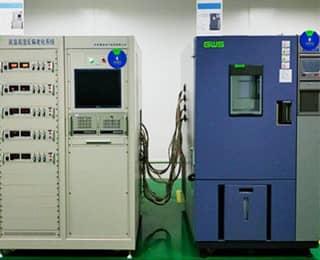 High temperature and high humidity reverse bias experimental systemThe test principle of the high temperature and high humidity reverse bias test system is to accelerate the electrochemical corrosion of the metallized layer by applying reverse bias pressure to measure the resistance of the plastic encapsulation device to moisture.
High temperature and high humidity reverse bias experimental systemThe test principle of the high temperature and high humidity reverse bias test system is to accelerate the electrochemical corrosion of the metallized layer by applying reverse bias pressure to measure the resistance of the plastic encapsulation device to moisture.
 Diode constant current aging systemThe power supply provides the voltage, the current source provides the current, and the constant current source ensures that the current remains constant throughout the test. The temperature controller is used to adjust the temperature of the diode to simulate different operating environments. By combining these components, the system can simulate the performance changes of the diode over a long period of use and evaluate its durability and parametric stability.
Diode constant current aging systemThe power supply provides the voltage, the current source provides the current, and the constant current source ensures that the current remains constant throughout the test. The temperature controller is used to adjust the temperature of the diode to simulate different operating environments. By combining these components, the system can simulate the performance changes of the diode over a long period of use and evaluate its durability and parametric stability.
 Surge TesterThe surge tester can simulate the voltage surge that may be encountered in actual use, such as the transient surge current generated by lightning strike, switch operation, motor startup, etc., so as to comprehensively evaluate the anti-surge ability of electronic equipment.
Surge TesterThe surge tester can simulate the voltage surge that may be encountered in actual use, such as the transient surge current generated by lightning strike, switch operation, motor startup, etc., so as to comprehensively evaluate the anti-surge ability of electronic equipment.
 Cold and Heat Shock ExperimentThe test chamber can quickly convert between extremely high and extremely low temperatures, precisely controlling temperature and conversion time. The inside of the test chamber is usually divided into a high temperature zone and a low temperature zone, and the test sample is quickly moved between the two zones by a hanging basket or a moving device to simulate the instantaneous temperature transition shock.
Cold and Heat Shock ExperimentThe test chamber can quickly convert between extremely high and extremely low temperatures, precisely controlling temperature and conversion time. The inside of the test chamber is usually divided into a high temperature zone and a low temperature zone, and the test sample is quickly moved between the two zones by a hanging basket or a moving device to simulate the instantaneous temperature transition shock.
 VC TesterIt is mainly used to test the clamping ability of protection device materials after breakdown. The equipment mainly simulates the surge encountered in the application, the product limit voltage and the ability to protect the back-end circuit
VC TesterIt is mainly used to test the clamping ability of protection device materials after breakdown. The equipment mainly simulates the surge encountered in the application, the product limit voltage and the ability to protect the back-end circuit
 AutoclaveThe device is designed to test the properties of materials and products under extreme conditions. This equipment can simulate various environmental factors that may be encountered in the actual use of products in high temperature and high pressure environments, such as high temperature, high pressure, steam, etc., so as to test and evaluate the high temperature and high pressure performance of materials and products.
AutoclaveThe device is designed to test the properties of materials and products under extreme conditions. This equipment can simulate various environmental factors that may be encountered in the actual use of products in high temperature and high pressure environments, such as high temperature, high pressure, steam, etc., so as to test and evaluate the high temperature and high pressure performance of materials and products.
 Electrostatic TesterBased on the principles of electrostatic induction and charge measurement, the electrostatic tester can be used to measure the electrostatic charge on the surface of the device and evaluate its impact on the performance and reliability of the device.
Electrostatic TesterBased on the principles of electrostatic induction and charge measurement, the electrostatic tester can be used to measure the electrostatic charge on the surface of the device and evaluate its impact on the performance and reliability of the device.
 Weldability DeviceWeldability devices typically simulate the actual welding process by subjecting the sample to be tested to specific temperature and humidity conditions and then dipping it into molten solder to evaluate its weldability and solder adhesion. The device can precisely control the temperature, time and other parameters in the welding process, so as to ensure the accuracy and reliability of the test results.
Weldability DeviceWeldability devices typically simulate the actual welding process by subjecting the sample to be tested to specific temperature and humidity conditions and then dipping it into molten solder to evaluate its weldability and solder adhesion. The device can precisely control the temperature, time and other parameters in the welding process, so as to ensure the accuracy and reliability of the test results.